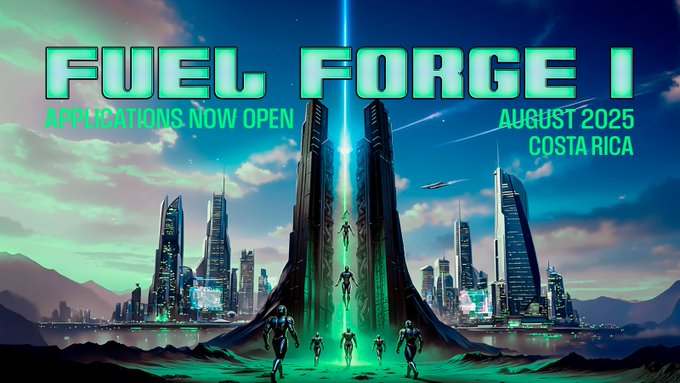Fuel Network: Reshaping the High-Performance Engine of Ethereum Rollups
Fuel Network is a modular execution layer protocol co-founded by blockchain pioneers Nick Dodson and John Adler, aiming to solve the core bottlenecks in Ethereum L2 scalability: traditional Rollups (such as Optimism and Arbitrum) are constrained by EVM’s single-threaded architecture, leading to gas fee spikes in high-concurrency scenarios (e.g., over $200 during NFT minting peaks).
This project separates the execution layer from the consensus layer, combining the UTXO model with a customized virtual machine (FuelVM) to enable parallel transaction processing and stateless client validation, achieving a peak single-core throughput of 12,000 TPS (50x that of EVM). The mainnet Ignition launched in October 2024, and Fuel was listed on Binance Alpha in June 2025 with an airdrop plan, marking its rise as critical infrastructure in the modular blockchain ecosystem.

This Token Insights article explores how Fuel Network improves Ethereum Rollup performance through the UTXO model and stateless design, and examines its token economy and ecosystem growth.
Technical Architecture: Three Engines Driving Rollup Evolution
FuelVM Virtual Machine: Core of Parallelization and Statelessness
Fuel’s core innovation lies in its customized FuelVM, which replaces the traditional account model with the UTXO (Unspent Transaction Output) model:
-
Parallel Transaction Processing: Uses Access Lists to pre-detect resource conflicts, enabling multi-threaded execution of non-dependent transactions. For example, AMM swaps and loan liquidations can proceed simultaneously, avoiding EVM’s queuing bottlenecks.
-
Statelessness: Introduces Predicates technology—validators only store a 32-byte UTXO hash rather than global state, reducing data storage needs by 90%. Ethereum co-founder Vitalik Buterin praised this as “one of the few credible solutions to the state bloat problem.”
-
Native Account Abstraction: Supports multisig wallets, customizable gas tokens (any ERC-20), and batch transactions.
Users can sign Fuel transactions directly with Solana wallets, greatly lowering the entry barrier.
Sway Language: Secure and Efficient Developer Experience
Sway, a language tailored for FuelVM, combines Solidity’s ease of use with Rust’s memory safety:
-
Static checks at compile-time prevent common vulnerabilities like reentrancy attacks;
-
Built-in debugger and formal verification framework boost development efficiency by 40%;
-
Compatible with EVM bytecode, supporting one-click Solidity contract migration.
See JuCoin Developer Center for a guide on modular blockchain development.
Modular Interoperability: A Liquidity Hub Across Ecosystems
-
Flexible DA Layer Support: Can connect to Ethereum (EIP-4844) or Celestia for data availability, switching dynamically based on cost—DA cost can be as low as 1/50 of Ethereum’s.
-
Seamless Cross-chain Messaging: Transfers assets between Ethereum/Solana in under 2 seconds via LayerZero.
-
Native Asset Integration: All assets (including custom tokens) are embedded at the protocol layer, removing reliance on third-party contracts.
Tokenomics: Dual Capture Model Tied to Ecosystem Growth
10 Billion FUEL Allocation and Scarcity Design
Token allocation focuses on long-term ecosystem development:
-
20% for community incentives (including 10% for airdrops),
-
33.1% to investors (24-month linear unlock),
-
31% for ecosystem and R&D (phased release).
Key utilities include gas fee payments (customizable), governance voting (e.g., node parameters), and staking for validator priority.
Deflationary Engine and Value Anchoring
-
50% Gas Burn: Half of network revenue is used to buy back and burn FUEL;
-
Staking Lock-Up: Validators must stake tokens to produce blocks, reducing circulating supply;
-
Ecosystem Multiplier: For every $100M increase in TVL, DApp service demand rises by 20%.
If daily mainnet volume reaches 1M transactions, annual burn may reach 8% of circulating supply.
Progress: Mainnet Validation and Ecosystem Surge
Ignition Mainnet Milestone (October 2024)
-
Achieved 600+ TPS (Ethereum DA scenario), gas fees as low as $0.0002, 1s block time;
-
Passed dual audit by Certik/Zellic, Certik Skynet security score 80.47;
-
Supported 80+ dApps, with daily transaction volume of 100K–200K.
Key Developments in 2025
Exchange Listings and Airdrop
-
Listed on Binance Alpha on June 29; users with ≥170 points can claim 5,550 FUEL (costing 15 points);
-
Listed on Gate.io in July, current price $0.013 (down 85% from ATH $0.086).
Ecosystem App Surge
-
Mira DEX: Order book engine using FuelVM, achieving 5,000 TPS;
-
Swaylend: First lending protocol with liquidation-free leverage;
-
Spark CLOB: Predicate-based limit order book, revolutionizing trading.
Challenges and Prospects: Modular Era Breakthrough Path
Risk Warnings
-
Delayed Market Awareness: Despite technological innovation (statelessness, parallelism), market cap is only $200M and TVL below $40M;
-
Competitive Pressure: AltLayer has 2,000+ monthly devs, Fuel ecosystem only 500+;
-
Unlock Risks: Investor tokens unlock from Q4 2025, comprising 33.1% of total supply.
Growth Catalysts
-
Airdrop Conversion: If 30% of Binance Alpha airdrop participants stake, network stability will improve;
-
AI Computation Demand: Distributed AI training needs high-concurrency settlement—FuelVM fits real-time inference scenarios;
-
Cross-chain Expansion: 2025 roadmap includes connecting L2/L3, supporting state hydration.
Industry Paradigm Shift
Fuel is validating the golden rule of modular blockchains:
Optimal execution layer design enables Rollups to balance high performance and decentralization, breaking the “impossible triangle.”
If the Q4 2025 goals (200 app chains, 2,000 developers) are met, Fuel will become the core engine for large-scale Web3 apps, pushing DeFi and real-time prediction markets past performance ceilings.
The essence of scalability is resource decoupling—Fuel’s UTXO model and Predicates are the execution-layer cornerstone of the modular stack.





